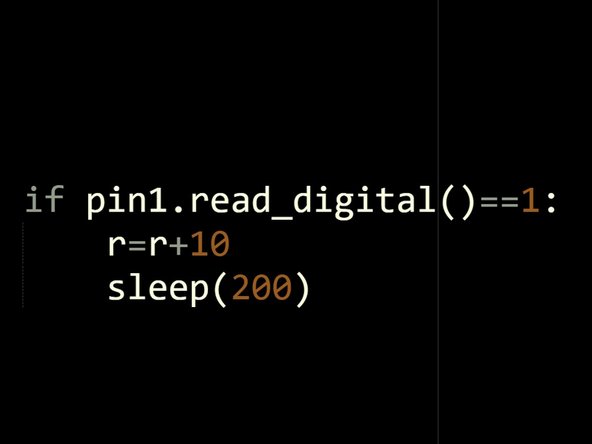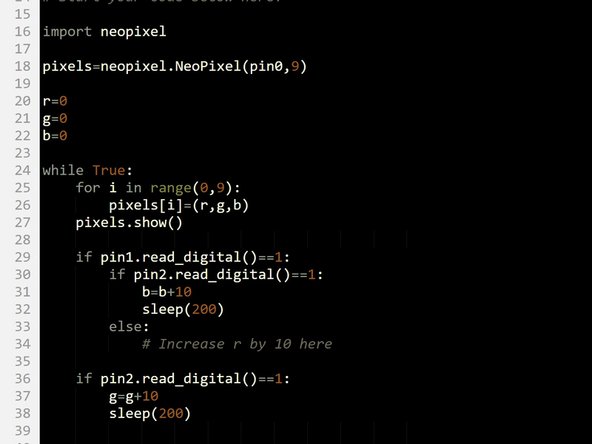Introduction
Let's use the Sparkle module and some switches to make a colour mixer!
-
-
Remember how each Sparkle contains 3 different colour LEDs?
-
We're going to make a program using variables, that allows you to change the Sparkle colour using 2 switches.
-
Assemble your robot like the picture first!
-
-
-
Import the neopixel code, and setup the neopixels at the start of the program as before.
-
We are going to need 3 variables this time - one for red, one for green, and one for blue
-
Add three new variables at the top of the program.
-
Call them r, g and b (for red, green and blue), an initialise them to 0.
-
We're going to use each of these variables to remember the amount of red, green and blue light we want.
-
-
-
Our program needs to always be updating the colour of the Sparkles, so when the variables change, the Sparkles change too!
-
Add a while True: loop, and add some lines that continually set all the sparkles using the values in the r,g, and b variables.
-
-
-
Before we can test it, we need to set r,g, and b to something other than 0, or the sparkles won't do anything!
-
Change the values to whatever you like, and test your program so far.
-
-
-
Now let's add some blocks to let use change the colour of the Sparkles using a switch.
-
You will need to add the two switches to your robot - plug them into P1 and P2.
-
Inside the loop, add an if statement that checks if the first switch (P1) is pressed.
-
If the switch is pressed, increase r by 10.
-
Add a sleep of 200 milliseconds after r is increased. Otherwise, holding down the switch will change r very quickly!
-
At the start of the program, set r, g and b to 0 again so you can see what is happening more clearly when testing your program.
-
There are some hints in the picture if you need them!
-
-
-
You probably noticed when testing your program that if you press the button enough times, the amount of red seems to start from zero again.
-
This is because the amount of red, green and blue in a Sparkle cannot be more than 255!
-
When r is more than 255 (when you have pressed the button more than 25 times), the Sparkle will show the value of r minus 255.
-
For example - 260 is more than 255, so the Sparkle will actually show 260-255=5!
-
-
-
We can now change the amount of red, but we want a colour mixer! Let's add another colour using the other switch.
-
Add another if statement, that checks the second switch (P2) and increases g by 10 if it is pressed.
-
This should be quite similar to the first one!
-
Make sure to test your program properly before moving on. What do you notice when you add equal amounts of red and green?
-
-
-
You may have noticed that we have run out of switches for the third colour, blue - but there is a solution!
-
What if we made a program that could increase b by 10 if both switches are pressed at the same time?
-
To do this, inside the if statement that checks the first switch, put an if/else statement that checks the second switch.
-
If the second switch is pressed as well, increase b by 10 instead.
-
Else, just increase r by 10 as before.
-
Don't forget to wait 200 milliseconds!
-
There are some layout hints in the picture if you need them.
-
-
-
You've probably found the last program doesn't quite work correctly - if you press both switches, the blue and green both increase!
-
This is because the second if statement is still true if we are holding down both switches, so g is also increased by 10.
-
Add an if/else statement inside the second if statement just like the one inside the first if statement to fix this.
-
Congratulations - you have made a switch controlled colour mixer!
-
-
-
When r, g and b are all the same, the Sparkles will be white.
-
Add code to your program to:
-
Check if r, g and b are all the same
-
If they are, sound the buzzer!
-
You will need to add the buzzer module and plug it into P8.
-
Here's a hint - you can check if 1 condition AND another condition is true by simply writing and - for example, if pin1.read_digital()==1 and pin2.read_digital()==1 is only true if both P1 and P2 are pressed.
-












